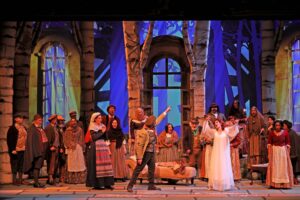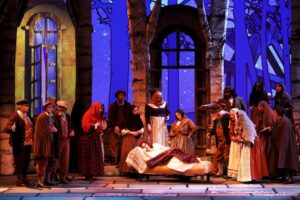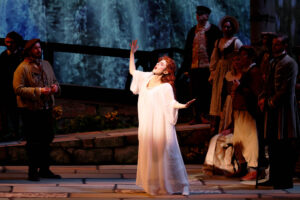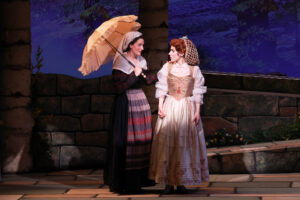La sonnambula
Vincenzo Bellini, Composer; Felice Romani, Libretto
West Bay Opera

In the early nineteenth century for some strange reason, the height of fashion in European stage works was to include somnambulism, or sleepwalking. With Felice Romani contributing the libretto, Vincenzo Bellini followed the popular trend by premiering in 1831 a two-act opera in the bel canto style entitled La sonnambula, one based on a popular, French ballet-pantomime. West Bay Opera opens a big-sounding, stage-filling La sonnambula with a cast of principals who overall conquer triumphantly the range challenges the composer has given them, with a chorus that reigns supreme in melodic harmonies, and an orchestra that delivers Bellini’s score with both subtlety when accompanying arias and grandeur when blossoming into full sound.
Peter Crompton’s set and projection designs beautifully and resplendently establish the scene of a small Italian village surrounded by golden, autumn foliage and positioned next to the massive water wheel of the town’s mill. The town is all abustle over the marriage about to take place between the mill owner’s adopted daughter, Amina, and a local farmer/landowner, Elvino. Everyone is delighted with the match except innkeeper, Lisa, who was once betrothed to Elvino before being dropped for Amina.

Just as the marriage contract is signed and a ring is on Amina’s finger, a noble stranger arrives, whom the townspeople soon surmise is the long-lost son of the now-dead lord of a nearby castle. Count Rodolfo causes quite a stir, especially when he quite obviously flirts with the bride-to-be and she seemingly responds, flattered — all to the growing jealous reaction of the groom.

As shadows creep in the forest, the Count is encouraged to spend the night to avoid the white-draped phantom whom all declare often haunts the nearby woods and paths, a woman most ghastly. The Count is amused but not convinced; however, he does retire to a room in Lisa’s inn. To his surprise, during the night, in walks through the window a pale-skinned woman all in white. He soon realizes that it is a sleep-walking Amina, who sings in her sleep about her love of Elvino. As the Count readies to leave the room being careful not to wake her, Lisa comes in to check on the Count and sees Amina in a night gown in his room. And thus sets up the high-spirited drama to come as she quickly informs the entire town — of course including her beloved and once-betrothed Elvino — of the scandalous situation. That Amina is only sleepwalking and is in fact the oft-supposed town ghost does not cross her or anyone else’s mind as guilt of the bride’s betrayal is at once assumed.
From the opening moments when Michelle Allie Drever sings of Amina’s gratitude to the townspeople for their best wishes for her upcoming nuptials through her expressions of love for Elvino and then on to her pleading of innocence after being discovered sleeping in the Count’s bedroom, her soprano voice rings with much vibrato with notes often quivering in their trills as she delivers in full bel canto style. As magnificently as she sings with power often reaching and sustaining notes steps above high-C, there are times when the warbling of her notes become a bit much, especially when accompanied by a tendency to overact, to flail outstretched hands, and to use facial expressions like one might have once seen in silent movie close-ups.

However as the opera progresses, her Amina’s vocals relax to more natural tones to permit her profound voice to shine forth unencumbered with overdone trembles. That is particularly true whenever in duet with Elvino when their voices intertwine in close harmony as in the a cappella duo they sing as they sign the marriage contract of their love, intoning “since the day a god united our hands.” Further, when delivering the opera’s most famous aria — that of the sleepwalker in the climax of Act II — Michelle Allie Drever’s ghostly Ariana sings with less flowery, more restrained tones and with much more striking, genuine emotions of the grief and sadness the sleeping Ariana is feeling about the love she has lost of Elvino.
For his part, Chris Mosz time and again does not fail to impress with a tenor voice that floats with ease through increasing scales to land on clear, sustained notes in upper ranges as his Elvino declares his love, then his rejection, and finally his love again of Amina. As both actor and singer, Chris Mosz’s skills prove to have just the right touches to make each appearance on the stage compelling and memorable.
The expressive purity and depth of Casey Germain’s bass also leaves a lasting impression as he sings with pleasant, wholesome tones the role of Count Rodolfo. His Count is definitely on the cusp of being a brute as he so boldly flirts with the bride-to-be upon his arrival to the village, but he quickly becomes much more noble as the one person beyond her own mother who steps in to declare Amina’s innocence to a still-disbelieving Elvino.

The defending mother, Teresa, looks squarely with indignation and near disgust in the faces of the entire, accusing town and pushes up against the offending Elvino as Courtney Miller also wonderfully sings in resounding, rich mezzo soprano her belief of her daughter’s innocence. In the first act’s final scene after the entire village has arrived to see Amina sleeping in the Count’s bedroom, her Teresa joins the shocked and innocent Amina, the angered Elvino, the now-hopeful Lisa, and the entire turn-coat town in one of the evening’s most powerful, superbly staged and delivered numbers as each and all express their emotional reaction to the surprise discovery.
From a sheer perspective of acting prowess, Shawnette Sulker is the star of the night in her role as the pouting, plotting Lisa. Often from the silent sidelines, Lisa’s facial and body stance reactions are worth the price of the ticket. During declarations of love by Amina and Elvino, the arrival of the handsome Count, the reactions of Elvino as he turns against Amina, and then of the town’s and Elvino’s realization of Amina’s innocent, sleepwalking proof of Lisa’s own accusation — through each step of the story, it is well worth more than just an occasional glance to catch what is going on in Lisa’s head as becomes so evident visibly.

But more important, Shawnette Sulker also sings with a soprano excellence that proves its mettle over and again, hitting top notes with sustained swellings that swoon in beauty. She particularly wows us all when Lisa expresses to the townspeople in a melodic stream of joyful notes and in held tones of high soprano her delight that she is now going once again to be Elvino’s bride (or so she believes).
Adding to the joy of the evening are the twenty or so voices of the chorus of villagers. Their remarkable control of dynamics, their exacting separation of phrases when describing the town’s ghost, and their overall full sound of well-placed harmonies make each appearance welcomed and highly enjoyed.
Likewise, the twenty-plus orchestra under the direction of José Luis Moscovich deserves kudos for its own excellence, with particular stand-out moments when both high and low strings at times accompany soloists with background, plucked strings, often with also the serenade of Arthur Austin’s lovely clarinet.

Callie Floor’s attention-drawing costumes help provide distinct personalities to each of the many townspeople as well as to establish the nobility of the Count, the flirty nature of Lisa, and the haunting side of sleepwalking Amina. David Gillam’s design of make-up and wigs provide many finishing touches, although maybe a bit too harshly in cosmetic treatment of the leading lady herself.
There are times when the two-hour, thirty-minute (plus intermission) evening does seem to drag a bit in its scenes and arias , and sometimes the actions of actors and even townspeople become a bit too cartoonish. But overall, the strength of the voices, the chorus, and the orchestra ensure that West Bay Opera’s technically demanding, bel-canto showcasing La sonnambula is definitely a good reason to head to Palo Alto’s Lucie Stern Center where audiences have a rare chance to witness and enjoy grand opera in an intimate setting.
Rating: 3.5 E
La sonnambula continues February 16, 22, and 23, 2025 in a two-hour, thirty-minute production (plus intermission) in production by West Bay Opera at Lucie Stern Center, 1305 Middlefield Road, Palo Alto. Tickets are available online at https://www.wbopera.org/ or in person/by phone at the box office Monday – Friday 1-5 p.m. at 221 Lambert Avenue, Palo Alto (650-424-9999).
Photo Credits: Otak Jump

Leave a Reply